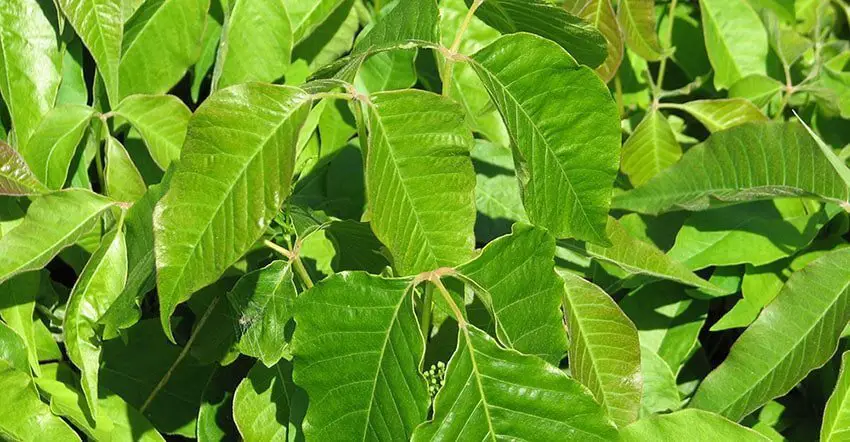How to Kill Poison Ivy – The Surefire Way

We’ve all been there… one minute, you are enjoying your time outdoors, hiking, or gardening, and before you even realize it you find yourself in the midst of poison ivy. A full break out, complete with rash, blisters, oozing, and scabs is the worst. The focus of today is how to identify, treat, control, and eradicate the annoying vines.
Proper Poison Ivy Identification
Poison ivy is often confused with other plants, so understanding the form, color, texture, and habitat of the vine is a vital key. The botanical name is long and tedious because multiple varieties exist, but the simple explanation is that poison ivy is a native American woody, vine plant. One variety can be a non-climbing shrubby plant. The other is a sneaky little plant, which grows as a shrub, as a ground-cover, or as an aggressive vine.
Leaves of Three
You’ve probably heard the well-known saying, “leaves of three, let it be”. It is highly advised that you heed the warning. However, more than one type of poisonous plant has “leaves of three”: poison oak and poison sumac also have leaves of three. Poison oak has lobed leaves that may be symmetrical or asymmetrical. Poison sumac grows on a single stem, with leaflets – a leaf like structure that together make up a compound leaf – usually, one stem with alternating leaves on the right and the left, culminating in a three-point leaf tip. Contrary to both poison oak and poison sumac, poison ivy has three pointed leaves, on three separate stems, at the tip of one individual stem from the branch/vine. The vine variety of poison ivy has many hundreds, even thousands, of small hair like tendrils that secure the vine to the climbing structure.

Color Markers
Additionally, the various poison vines have color markers to help to distinguish them. Poison sumac has a red stem in the spring. Poison ivy’s berries that grow white, even at maturity, and it’s leaves are red in spring.
Precautionary Measures
You now know how to identify poison ivy, but are not quite ready to tackle the itch monster. It’s not the plant that causes a reaction; it’s an oil called urushiol that is the menace. Actually, urushiol is found in other plants as well. Green mangos carry the oil and people who are sensitive to the oil can get what’s known as mango mouth.
Knowing the Symptoms & Treatment
Take Action
If you think you have been exposed to poison ivy, immediately remove any contaminated clothing. Wash your clothing in hot water and soap. Wash the soles of your shoes with hot water and soap as well. Any tools or gear that may have come in contact with the urushiol can carry the contaminant too, so wash everything. You need to wash yourself too. You can use soap or several products that are on the market, such as Technu Outdoor Skin Cleanser. Wash from the top of your head down, using cool water (hot water spreads the oils on skin, furthering the infection) and soap, wash in a downward motion, working not to scrub and open areas of the tissue for the oil to penetrate.
You should also know that you could unknowingly pick up urushiol from the clothes, shoes, tools, or gloves that someone else has contaminated. You can also contract the rash from someone else’s rash. The important thing to remember is the rash incubates in approximately seven days from contact, so a quick response to exposure is the best defense.
Blisters & Oozing
As we mentioned, if you are unaware that you have come in contact with the oils it takes about seven days for the first signs to manifest. Usually, the infected area of the skin will become chaffed in appearance, followed by small blisters that are rimmed in red inflamed tissue. Do not pop the blisters! Instead, wash the area with cool water and soap, as discussed above. Then apply a drying agent to the area, such as Caladryl, and leave the area open to the air as much as possible. WebMD has a much more thorough discussion on the topic of treatment for poison ivy. There are several products available over the counter to help ease the discomfort, including antihistamine, a cold compress, and hydrocortisone cream. In severe cases, we recommend you seek medical help from a doctor, who can administer a dose of steroids.
Personal Protection Equipment
Now that you have decided to take on the poison ivy removal, you need to gather your personal protection equipment (PPE). These PPE tools are your greatest defense against contamination and infection. The degree of coverage is entirely up to the user. We recommend shielding your eyes with safety glasses. Remember never to wipe your face or eyes while getting rid of ivy. Urushiol is not particular, it can infect the soft tissues of your eyes and that would be simply miserable. Clothing can be chosen with a little more personal preference. Long sleeves, long pants, gloves, and closed toe shoes are necessary, but you can choose to purchase a simple one piece, all-purpose, disposable coverall available at any home improvement store (check the paint department). Otherwise, use our own work clothing and sanitize them after you are done. Shoe covers are available at home improvement stores as well, but rubber boots work just fine. Finally, cover your hands. You can use disposable latex gloves; however, you will be working in a garden area and there is a chance the latex can be torn or punctured, exposing your hand to the urushiol and infection. Inexpensive rubber gloves sold for housework or gardening might be a better choice and can be disposed of when you are finished. Whatever you do, do not use leather or breathable fabric gloves, both options expose your hands to urushiol as you work and then again in the future.
Removal Techniques
The best way to control poison ivy will be entirely dependent on where the ivy is growing. As mentioned earlier, some grow in grassy areas or beds as ground cover and others grow up trees and around shrubs. Because poison ivy is a woody plant, it requires an herbicide designed specifically for woody plants. That means that the plants around it may, or may not be, affected by the treatment, so always read the product labels before treatment. Additionally, the treatment will work best if you first cause a cut or opening into the plant system and then apply the herbicide.
For poison ivy growing as a small shrub or in grassy area or bed, apply the herbicide of choice carefully and according to the label. In beds, where the ivy is isolated to specific areas, a non-selective herbicide, like Roundup®, works well. Using hand pruners, make cuts to the largest stalks you can find and spray the entire area liberally and allow to sit for a short period. You can remove the ivy you see but the root system that is unseen, under the dirt, will also ingest the herbicide and die as well.
For vines on trees, use an axe or hatchet to severe the vine at the ground (but do not cut the tree), then go up the tree approximately two feet and create another cut. Using the axe head, pry the cut segment off the tree and dispose of it in a sealed bag. Apply the herbicide directly to the cut openings of the vine. Systemically, the herbicide will kill the vine from within. Don’t bother removing the vine further up the tree, simply allow the vine to wither and die from within. You can remove the vine later if you like.
Some people like to burn out the ivy with a controlled burn, but we would advise against this method since the irritants can be spread through the smoke infecting people away from the fire, and fires actually fertilize and activate the ground it clears. Therefore, in a few short weeks, everything grows back healthier than before. Our advice is to stick with the herbicides available to consumers.
Commercial Products
The best treatments for poison ivy can be found at your local garden center or hardware store. Listed below are just a few of the trusted products available for woody plant control and are formulated to treat poison ivy specifically. Each product is formulated differently; always remember to read the label for proper application.
- Ortho® MAX® Poison Ivy & Tough Brush Killer Concentrate
- Roundup® Poison Ivy Plus Tough Brush Killer
- Bayer Brush Killer Plus
Call In the Pros
If the thought of getting rid of ivy on your own is too much, call in the reinforcements, the professionals. On example of these professionals is http://www.poisonivyremoval.com/. Based in the northeastern continental United States, this company touts being “the nation’s poison ivy guys.”. Although you might be outside of their extensive, multi-state, service area, landscape service companies in your area are capable of serving you too. A simple Google search should be sufficient to locate a professional near you.
Conclusion
The quickest and fastest way to get rid of poison ivy is not always the best way to get rid of poison ivy. These quick fixes deal with surface problems but not root systems of the plants. So make a plan and take the time needed to complete the job for the last time.

